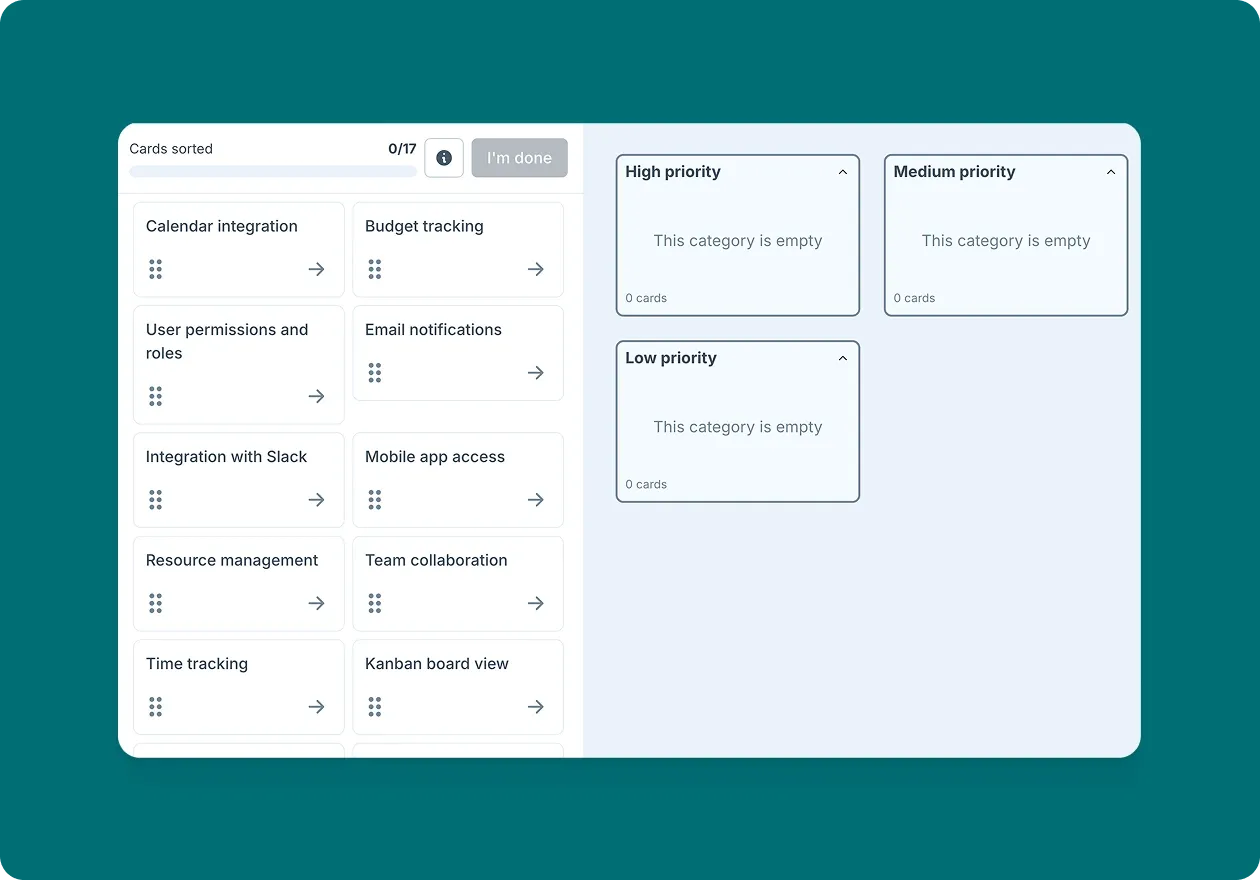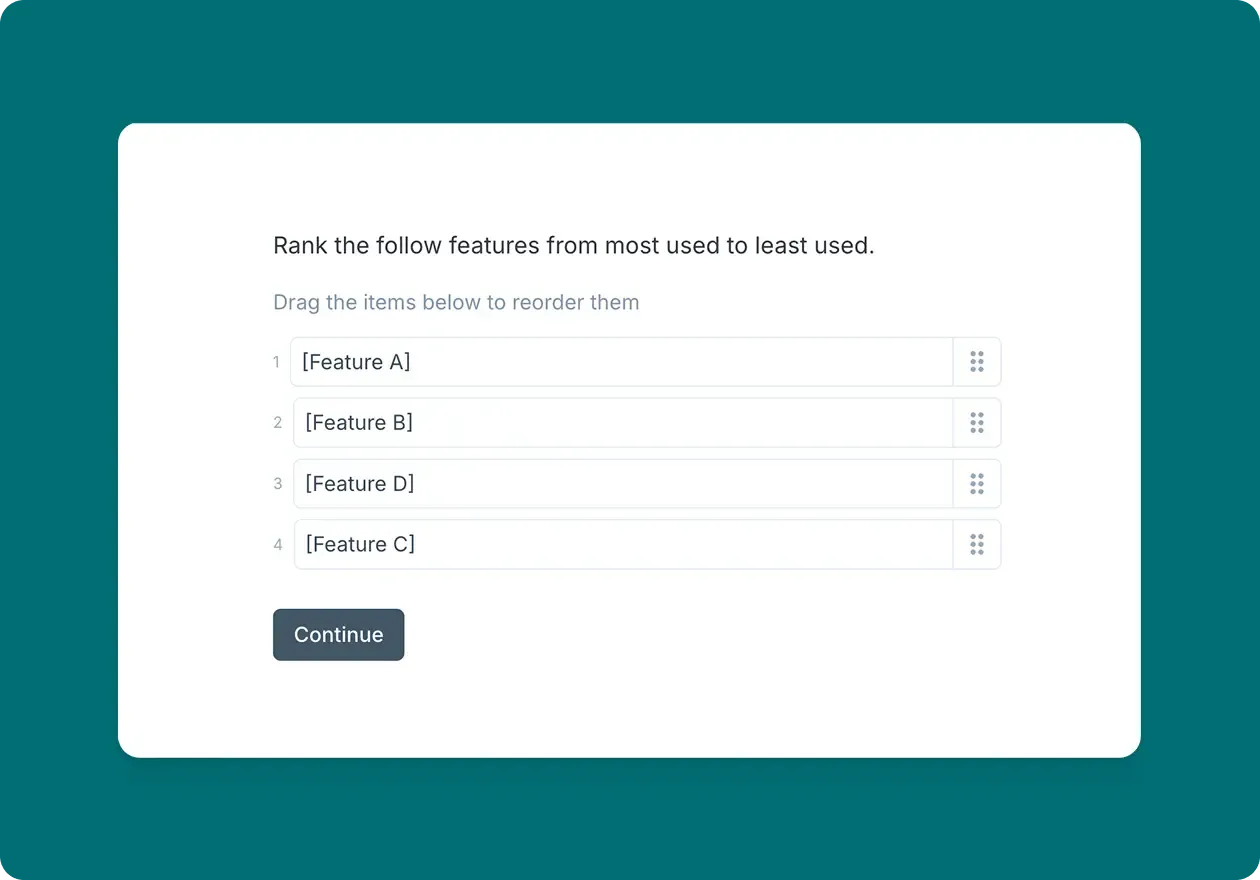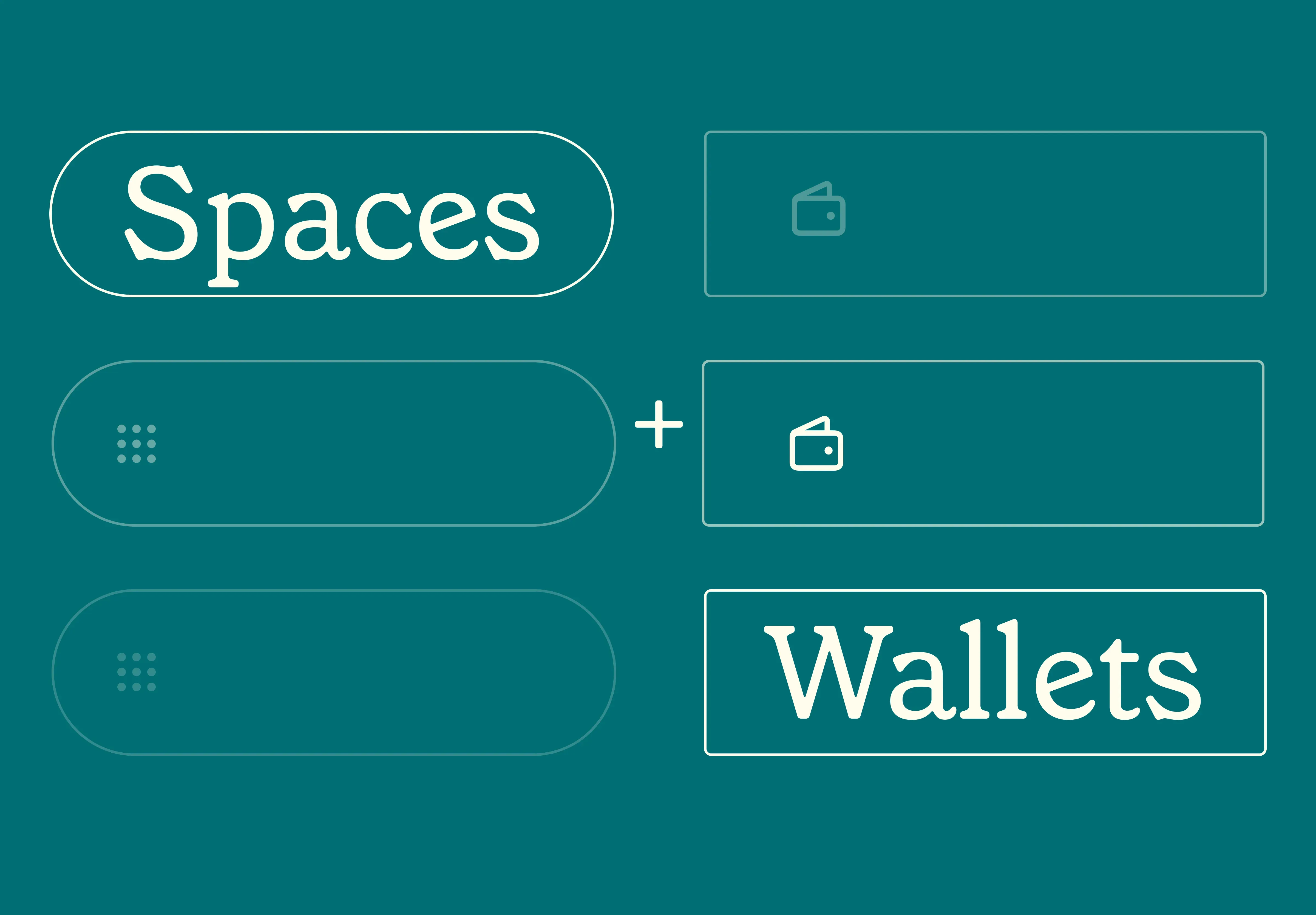10 Sep 2025
|24 min
How to build a product roadmap
Learn the essential steps and key considerations for creating an effective product roadmap that aligns teams, prioritizes features, and drives your product vision to success.

The disconnect between product vision and execution creates confusion and overwhelm for even the most talented teams.
Without a clear roadmap, product managers find themselves constantly firefighting, teams work in silos on conflicting priorities, and stakeholders lose confidence as deadlines slip and features fail to materialize.
A product roadmap serves as a single source of truth, showing how you move from vision to launched product and beyond. Just like a travel map guides you from point A to point B, a well-crafted product roadmap transforms disorder into strategic alignment.
Whether you're launching your first product or scaling an enterprise solution, this guide will help you build roadmaps that unite teams, satisfy stakeholders, and deliver real value to users.
Key takeaways
Start with user understanding, not assumptions. Great roadmaps are grounded in real user research – from jobs-to-be-done surveys to usability testing.
Balance vision with flexibility. Your roadmap should provide clear direction while staying adaptable to new insights and market changes. Think outcomes over outputs, and use confidence levels to communicate uncertainty honestly.
Make it collaborative, not dictatorial. The best roadmaps emerge from cross-functional input and stakeholder alignment. Involve teams in the process and tailor your message to different audiences – executives need business impact, while development teams need technical context.
Measure what matters. Track delivery velocity, but more importantly, measure whether you're actually solving user problems and moving business metrics.
Iterate based on learning. Use research tools and user feedback to validate your assumptions continuously. The most successful teams make roadmapping an ongoing conversation, not a quarterly planning exercise.
Start smart
Build roadmaps on real user insights, not assumptions. Get validated feedback from 690K+ participants – try Lyssna free today.
What is a product roadmap?
A product roadmap is a strategic document that communicates your product's vision, direction, and priorities over time. It bridges product strategy and day-to-day execution, showing not just what you'll build, but why it matters.
Unlike a simple project plan, a roadmap provides context and flexibility. Modern roadmaps are living documents that reflect market changes, user feedback, and strategic pivots. They communicate intent rather than promises, focusing on outcomes over outputs.
Product roadmap done right:💡Slack exemplifies this perfectly. Initially a standalone messaging tool, Slack strategically used its product roadmap to transform into a comprehensive collaboration platform.
By focusing on integrations and extensibility, they prioritized connections with third-party tools like Google Drive, Dropbox, and Salesforce, while developing APIs for custom workflows.
This roadmap-driven evolution helped Slack become a central hub for workplace productivity and a leader in enterprise software.
3 strategic questions every product roadmap must answer
For new product managers, think of a roadmap as your product's story – where you've been, where you are, and where you're going. It answers three critical questions: What problems are we solving? In what order? And why does this sequence make strategic sense?
Question | What it addresses | Strategic impact |
|---|---|---|
What problems are we solving? | User pain points and market opportunities | Ensures product-market fit |
In what order? | Prioritization and sequencing | Optimizes resource allocation |
Why does this sequence make strategic sense? | Logic behind decisions | Builds stakeholder confidence |

Why you need a product roadmap
Product roadmaps solve fundamental organizational challenges. Without one, engineering builds misaligned features, sales promises unavailable capabilities, and executives question product investments.
4 core benefits of building a product roadmap
Benefit | Impact | Example |
|---|---|---|
Organizational alignment | Single source of truth for all teams | Engineering plans architecture, marketing prepares campaigns, sales sets realistic expectations |
Prioritization tool | Transforms requests into strategic discussions | "Can we add this?" becomes evaluation against roadmap goals |
Scope protection | Prevents feature creep and maintains focus | Every new request measured against core objectives |
Trust through transparency | Builds stakeholder confidence | Fewer "when will this be ready?" questions, more strategic "what should we build?" discussions |
Product roadmap vs related documents
Understanding how a roadmap differs from other product artifacts prevents confusion and ensures each document serves its intended purpose. New product managers tend to conflate these documents, creating roadmaps that are either too detailed or too vague.
Quick reference table
Document | Purpose | Time horizon | Level of detail | Key question |
|---|---|---|---|---|
Roadmap | Shows strategic themes & goals | Quarters/Years | High-level outcomes | What are we trying to achieve? |
Backlog | Lists specific work items | Sprint/Weeks | Detailed tasks & stories | What specific work needs to be done? |
Strategy | Defines market approach | 2-5 years | Conceptual & directional | How will we win? |
Release plan | Coordinates launches | Days/Weeks | Operational specifics | When exactly will we ship? |
Roadmap vs backlog
What they show
Roadmap: Strategic themes and goals over quarters (e.g. "Improve onboarding experience," "Enable enterprise capabilities").
Backlog: Tactical details – specific user stories and tasks that implement these themes.
Key question each answers
Roadmap: "What are we trying to achieve?"
Backlog: "What specific work needs to be done?"
Roadmap vs strategy
Core purpose
Strategy: Defines your approach to winning in the market – your target customers, value proposition, and competitive differentiation.
Roadmap: Translates this strategy into time-bound initiatives.
Think of it this way
Strategy is your theory of how to win.
The roadmap is your plan to execute that theory.
Example
Strategy says: "We'll win by being the easiest tool to adopt."
Roadmap shows: Specific onboarding improvements over time to achieve that goal.
Roadmap vs release plan
Level of detail
Release plans: Focus on operational details – exact dates, dependencies, and deliverables for launching specific features.
Roadmaps: Operate at a higher level, showing themes and outcomes rather than specific releases.
Scope: A single roadmap initiative might span multiple releases.

Types of product roadmaps
Different roadmap types serve different purposes – choosing the right one depends on your product stage, industry constraints, and how much uncertainty you're navigating.
Methodology-based roadmaps
Your development methodology fundamentally shapes how you structure and maintain your roadmap. Each approach offers distinct advantages depending on your organization's culture, market dynamics, and stakeholder expectations.
Methodology | Best for | Time approach | Key strength | Example use case |
|---|---|---|---|---|
Agile | Rapid change environments | Now/Next/Later or quarters | Quick pivots & user feedback | Spotify's "bets" for user value |
Waterfall | Regulated industries | Fixed milestones & dates | Predictability & compliance | FDA-approved medical devices |
Hybrid | Mixed requirements | Flexible + Fixed elements | Balance of structure & agility | Platform migrations + features |
Agile roadmaps
Core principle: Embrace uncertainty and change through the agile methodology
Structure
Themes and goals instead of fixed deliverables
Time horizons like "Now, Next, Later" or quarterly objectives
No specific dates for distant items
Strengths
Incorporate user feedback quickly.
Pivot based on learning.
Adapt to market changes.
Real-world example: Spotify focuses on "bets" rather than features – each bet represents a hypothesis about user value that teams validate through rapid experimentation.
Waterfall roadmaps
Core principle: Provide predictability through sequential planning
Structure
Clear milestones and dependencies
Phases that must complete before the next begins
Timeline mapped months or years in advance
Best suited for
Products with regulatory requirements
Hardware components
Enterprise clients needing long-term commitments
Real-world example: Medical device software requiring FDA approval must account for documentation phases, clinical trials, and regulatory review periods that can't be compressed or reordered.
Hybrid approaches
Core principle: Combine elements of both methodologies
Common patterns
Waterfall for major platform migrations, agile for features
Strict timelines for compliance, flexible for customer-facing work
Fixed dates for external dependencies, iterative for internal work
Format types
The format you choose shapes how stakeholders perceive and interact with your roadmap. Different formats emphasize different aspects of your product journey.
Format | Focus | Best use case | Limitations |
|---|---|---|---|
Timeline | Specific dates & sequencing | Mature products, cross-team coordination | False precision, frequent updates |
Now-Next-Later | Relative priority | Early-stage products, high uncertainty | Vague commitment expectations |
Outcome-based | Goals over features | Unclear solutions, innovation needed | Harder to track progress |
Theme-based | Strategic groupings | Big picture communication | May hide specific deliverables |
Timeline roadmaps
What they show: Initiatives plotted against specific dates or quarters
Excel at
Showing sequencing and dependencies
Coordinating across teams
Providing clear expectations
Limitations
Can create false precision about the distant future
Need frequent updates as priorities shift
Best for: Mature products with predictable development cycles
Now-next-later roadmaps
What they show: Initiatives grouped by relative priority, not dates
Structure
Now: Work currently in progress
Next: What's queued up
Later: Future possibilities
Key benefit: Reduces pressure for exact dates while providing directional guidance
Best for: Early-stage products where learning might dramatically shift priorities
Outcome-based roadmaps
What they show: Goals rather than features
Example transformation
Instead of: "Build mobile app"
Show: "Enable customers to engage on-the-go"
Key benefit: Keeps teams focused on solving problems rather than shipping features
Best for: When solutions aren't clear or you want to encourage innovation
Theme-based roadmaps
What they show: Related initiatives grouped into strategic themes
Examples
"Improve onboarding"
"Expand enterprise capabilities"
"Enhance platform performance"
Key benefits
Helps stakeholders understand the bigger picture
Shows how individual features contribute to larger goals
Themes can span multiple quarters, providing continuity
Best for: Communicating strategy while maintaining flexibility in execution

Pre-roadmap research and planning
Great roadmaps aren't built on assumptions. Instead, they're grounded in a deep understanding of your users, market, and strategic direction.
Before plotting features on a timeline, invest in the foundational research that transforms your roadmap from a wishlist into a strategic plan for delivering real value.
Defining your product vision and strategy
Your product vision serves as the North Star for every roadmap decision. Without a clear vision, your roadmap becomes a collection of features.
Creating your vision
Start by articulating the change you want to create in the world:
What problem are you solving?
For whom?
Why does this matter?
Your vision should be ambitious enough to inspire but concrete enough to guide decisions.
Vision quality | Example |
|---|---|
❌ Too vague | "Make communication better" |
✅ Clear direction | "Enable every distributed team to collaborate as effectively as if they were in the same room" |
From vision to strategy
Strategy is your theory of how to achieve that future state. It involves hard choices:
Which customers to serve first
Which problems to solve now versus later
Which capabilities to build versus buy
These strategic choices create the constraints that make roadmap prioritization possible.
Context matters
Role | Focus |
|---|---|
New PM at an established company | Understand existing strategic commitments and find opportunities within those constraints |
Founder | Make fundamental choices about market positioning |
Experienced PM at a startup | Balance vision with the pragmatic need to find product-market fit |
Making it measurable
Your objectives and key results (OKRs) translate strategy into measurable goals.
Rather than "improve user experience," set specific targets like:
"Reduce time-to-first-value from 7 days to 24 hours"
"Increase weekly active usage by 40%"
These metrics become the success criteria for your roadmap initiatives.
Understanding your users through research
Building a roadmap without user research is like navigating without a map– you might reach a destination, but it probably won't be where your users needed you to go. Deep user understanding transforms your roadmap from a list of assumptions into a validated plan for delivering value.
Jobs-to-be-done research
The jobs-to-be-done approach reveals the underlying motivations driving user behavior. Rather than asking what features users want, explore what they're trying to accomplish:
What progress are they seeking?
What's blocking them today?
Using our Jobs-to-be-done survey template, you can systematically uncover what users are really trying to accomplish, moving beyond surface-level feature requests to understand core needs.
Key insight: Companies often discover that customers aren't leaving because of missing features – they're leaving because the product has become too complex for their needs. This insight can lead to a roadmap focused on simplification rather than feature additions, delivering more value by removing friction rather than adding capabilities.
User interviews
User interviews provide qualitative context that surveys can't capture. Through conversations, you understand:
Workflows
Constraints
Workarounds that reveal opportunities for breakthrough improvements
Pro tip: A series of 5-8 interviews can uncover patterns that transform your roadmap priorities.
Quantitative validation
Surveys help determine whether insights from interviews represent broader patterns.
With Lyssna's research panel of 690,000+ vetted participants and 395+ demographic filters, you can quickly validate assumptions across specific user segments. This is particularly valuable when you need to prioritize between different user segment needs.

Market and competitive analysis
Understanding market dynamics prevents building in a vacuum. Your roadmap must account for external forces while maintaining focus on your unique value proposition.
Start with market trends
Ask yourself:
Is your market growing or consolidating?
Are new technologies creating opportunities or threats?
What regulatory changes might affect your product?
Industry | Example consideration |
|---|---|
Fintech startup | Open banking regulations might create new opportunities |
Enterprise SaaS | AI capabilities might become table stakes |
Beyond feature comparisons
Product competitive analysis goes deeper than feature lists. Understand your competitors' strategies, not just their products:
Where are they investing?
What customers are they targeting?
What partnerships are they forming?
This strategic intelligence helps you identify opportunities to differentiate rather than simply match features.
Validate through research
Test product concepts before committing resources. This ensures you're responding to real market needs rather than competitor marketing messages.
Remember: What competitors claim and what users actually value often differ significantly.

Building your roadmap: Step-by-step process
With your vision defined, users understood, and market dynamics mapped, you're ready to transform insights into action. This systematic process will help you build a roadmap that balances strategic ambition with practical execution.
Step 1: Gather and organize ideas
Ideas for your roadmap come from everywhere: customer feedback, sales requests, technical debt, competitive pressure, and strategic initiatives. The challenge isn't finding ideas but managing them effectively.
Create a systematic intake process. Rather than letting ideas scatter across emails, Slack messages, and meeting notes, centralize them in a single repository. For a small team, this might be a spreadsheet. For larger organizations, consider dedicated product management tools.
Categorize ideas as they arrive. Group them by:
Theme (onboarding improvements, performance enhancements)
Outcome (increase retention, reduce support tickets)
Stakeholder (customer requests, internal improvements)
This categorization helps you see patterns and identify which areas are generating the most feedback.
Before investing time in detailed analysis, validate that ideas address real problems. Early validation prevents building solutions in search of problems. Document the context around each idea:
Who requested it
What problem it solves
How many customers are affected
The potential business impact
Step 2: Prioritization framework
Prioritization transforms your idea backlog into a strategic roadmap. Without a clear framework, prioritization becomes a political exercise where the loudest voice wins.
User-driven prioritization
Put customer needs at the center. Using the prioritize product features template, have users rank feature importance, providing quantitative data for decisions. Our evaluate feature preferences template helps understand trade-offs users are willing to make when you can't do everything.
Traditional frameworks
These provide structure for balancing multiple factors:
RICE framework (Reach × Impact × Confidence ÷ Effort): This framework creates a priority score balancing value against cost.
Component | Example | Value |
|---|---|---|
Reach | 80% of users affected | 0.8 |
Impact | High impact on goal | 3 |
Confidence | High confidence in estimates | 0.9 |
Effort | 2 person-months | 2 |
Score | (0.8 × 3 × 0.9) ÷ 2 | 1.08 |
MoSCoW prioritization: This framework forces explicit decisions about what's essential.
Category | Definition | Example |
|---|---|---|
Must have | Non-negotiable for the release | Core functionality |
Should have | Important but not vital | Enhanced reporting |
Could have | Desirable if resources allow | UI polish |
Won’t have | Explicitly out of scope | Advanced integrations |
Value vs effort matrix: Visualizes the relationship between benefit and cost.
Quick wins: High value, low effort → Prioritize first
Major projects: High value, high effort → Plan carefully
Fill-ins: Low value, low effort → Do if time permits
Time wasters: Low value, high effort → Eliminate
Balancing priorities
Balance user research insights with business constraints. The highest user priority might not align with strategic direction or might not be technically feasible. Your framework should weight user needs heavily while accounting for:
Technical debt
Strategic alignment
Resource constraints
Step 3: Define timeline and milestones
Timelines transform priorities into commitments. The challenge is providing enough specificity to coordinate efforts without creating false precision about an uncertain future.
Start with your confidence horizon
For most products, confidence decreases exponentially with time. You might have high confidence in the next quarter, moderate confidence in the following quarter, and low confidence beyond six months. Structure your timeline granularity accordingly – detailed for near-term, thematic for long-term.
Work backward from key dates
Industry events, regulatory deadlines, and seasonal patterns become anchors for your timeline. If you're a tax software company, you must deliver certain features before tax season.
If you're launching at a major conference, work backward from that date. Ecommerce platforms need peak features ready before Black Friday. Meanwhile, education technology companies plan their major updates before the school year starts.
Build in buffer time
Research shows software projects typically take 2-3x longer than initially estimated. Rather than padding individual estimates, build explicit buffer time into your roadmap – perhaps 20-30% of capacity remains unallocated for discoveries and opportunities.
Recommended allocation:
70% committed to planned features and initiatives
20-30% buffer for discoveries, opportunities, and overruns
Define outcome-focused milestones
Create milestones that validate progress and value delivery.
Instead of "Backend API complete," define "Users successfully complete core workflow." Rather than "Database migration done," aim for "System handles 2x current load."
These outcome-focused milestones provide better progress indicators and create natural validation points.
Step 4: Choose your visualization
The way you visualize your roadmap shapes how stakeholders perceive and interact with it. Consider your audience, methodology, and communication goals.
Tailor views to your audience
Different stakeholders need different levels of detail and focus:
Executive stakeholders: Use high-level theme-based views that connect to business objectives. Show how initiatives ladder up to strategic goals and impact key metrics.
Development teams: Provide more detailed timeline views showing dependencies and technical initiatives. Include technical debt items and infrastructure work that enables feature delivery.
Customers: Focus on value delivery and problem resolution. Highlight when their pain points will be addressed without overwhelming them with internal details.
Design for clarity
Use color consistently to represent themes, confidence levels, or teams.
Keep text concise – if you need paragraphs to explain an item, it probably needs to be broken down further.
Ensure scannability with the most important information immediately visible.
Show relationships between items when dependencies exist.
Create multiple views from one source
Consider creating multiple views of the same roadmap from a single source of truth. Modern roadmapping tools make this easy, but even a well-designed spreadsheet can serve multiple audiences. The key is maintaining one authoritative version while presenting it differently based on who needs to see what.
Step 5: Validate with stakeholders
Validation transforms your roadmap from a plan into a commitment. Rather than seeking approval, focus on ensuring alignment, uncovering blind spots, and building the support network needed for successful execution.
Start with pre-validation conversations
Before presenting a complete roadmap, have one-on-one discussions with key stakeholders. Understand their priorities, constraints, and concerns. These conversations help you anticipate objections and adjust before formal review.
Present as a story, not a decree
When presenting your roadmap:
Start with vision and strategy to ground everyone in the "why"
Explain the rationale behind prioritization decisions
Use data from user research to support choices
Make it interactive – engage stakeholders in discussion rather than presenting a finished decision
Address concerns directly
Stakeholder | Common concerns | Your response |
|---|---|---|
Sales | "We're losing deals to competitors with feature X" | Show how roadmap addresses competitive threats while maintaining differentiation |
Engineering | "Technical debt is slowing us down" | Demonstrate allocated time for platform improvements and refactoring |
Customer success | "Customers need these bugs fixed NOW" | Highlight quick wins and support improvements in near-term plan |
Marketing | "We need differentiators for the next campaign" | Point to unique value props being built in the upcoming quarter |
Finance | "ROI timeline seems too long" | Share early validation milestones and incremental value delivery |
Document everything
Record decisions and rationale. Documentation becomes invaluable months later when people question why certain choices were made. Include:
Key decisions and trade-offs
Stakeholder feedback and how it was addressed
Assumptions and dependencies
Success metrics and validation criteria
Set expectations that the roadmap will evolve based on learning and changing conditions.

Presenting and socializing your roadmap
Transform your roadmap from a document into a shared vision by adapting your message for each audience and building genuine buy-in across the organization.
Tailoring your message by audience
Each audience needs different information from your roadmap. Successful communication requires translating your plan into language and formats that resonate with each stakeholder group.
Executive presentations
Connect initiatives to business outcomes – revenue, retention, market share. Show research-backed problem validation.
Example: "User research shows poor onboarding causes 40% of trial users to churn. Our Q2 onboarding improvements target a 15% increase in trial-to-paid conversion, worth $2M ARR."
Team presentations
Provide tactical depth with enough detail to identify risks and dependencies. Emphasize the "why" behind initiatives using user quotes and research findings that motivated priorities.
Customer communications
Focus on value delivery using customer-friendly language. Translate internal initiatives into benefits. Use themes rather than specific features to maintain flexibility.

Gaining buy-in and alignment
Buy-in isn't unanimous agreement. It's a shared understanding and commitment despite disagreements. The following strategies help build this alignment across diverse stakeholder groups.
Key strategies
Acknowledge trade-offs explicitly - Explain what you're not doing and why.
Use evidence-based decisions - Show preference testing and user research data.
Create shared ownership - Involve stakeholders in research and prioritization.
Build coalition support early - Address controversial initiatives in private conversations first.
Communication best practices
Effective roadmap communication goes beyond the initial presentation. These practices help maintain alignment and understanding over time.
Make data human
Transform abstract metrics into relatable experiences by connecting them to real user struggles.
Stay consistent
Maintain visual and verbal consistency across all communications:
Use the same terminology and color coding across all materials
Establish regular rhythms (monthly reviews, quarterly updates)
Create self-service resources for independent access
Embrace transparency
When priorities shift, explain what changed and why. Acknowledge uncertainty upfront rather than pretending false precision.

Maintaining and evolving your roadmap
Your roadmap isn't "done" when you publish it—that's actually when the real work begins. Here's how to keep it relevant, accurate, and valuable as reality unfolds.
Review cadence and updates
Different timescales need different conversations. Here's a rhythm that works for most teams:
Review type | Frequency | Focus | Typical outcomes |
|---|---|---|---|
Tactical updates | Weekly | Execution progress, blockers, minor tweaks | Adjusted timelines, resource shifts |
Strategic reviews | Monthly | Assumption validation, competitive moves | Reprioritized upcoming work |
Major revisions | Quarterly | Fresh research, market analysis, lessons learned | Significant strategic shifts |
Vision alignment | Annually | \Product strategy, company goals | Roadmap overhaul if needed |
Keep weekly updates lightweight as nobody needs another heavy meeting. Save the deep thinking for monthly and quarterly sessions.
Incorporating continuous feedback
Your best roadmap decisions come from learning what actually happened with your last ones.
Measure what you ship
Use the measure feature satisfaction template to check if delivered features hit the mark. This isn't just about validating past decisions – it shapes what you build next. If users love the simplified workflow but ignore the advanced features, that tells you something important.
Validate your solutions
Post-launch studies reveal the truth: did you actually solve the problem? That new onboarding flow was supposed to reduce time-to-value from 7 days to 1 day. Did it? If not, do you iterate or pivot?
Test before you invest
Quarterly preference testing with Lyssna's research panel gets you answers in days, not weeks. Test concepts before writing a single line of code. Modern development moves fast – your validation should too.
Managing change and expectations
Changes are inevitable. How you handle them determines whether stakeholders see you as reactive or strategic.
Communicate with context
When priorities shift, don't just announce the change – tell the story. What new information came to light? What assumption proved wrong? People accept change better when they understand the reasoning.
Show your confidence levels
Not everything on your roadmap is equally certain. Use visual indicators:
Committed (next quarter): 90% confidence
Planned (following quarter): 70% confidence
Directional (6+ months): 40% confidence
Build in breathing room
Plan for 70-80% capacity utilization, keeping 20-30% as buffer. When the CEO has an urgent request or a critical bug emerges, you can respond without throwing everything into chaos.
Pro tip: Keep a change log. Document what changed, when, and why. Six months later when someone asks "Why did we deprioritize X?" you'll have the answer.

Measuring roadmap success
You can't improve what you don't measure. But measuring the wrong things is worse than not measuring at all.
The metrics that actually matter
Metric type | What to track | Why it matters |
|---|---|---|
Delivery matters | Velocity, on-time delivery | Shows if you can execute |
Outcome metrics | Retention, task completion, conversion | Shows if you're solving real problems |
Satisfaction metrics | Feature NPS, user happiness scores | Shows if solutions hit the mark |
Alignment metrics | Team clarity scores, stakeholder confidence | Shows if everyone's rowing together |
Reminder: If outcome metrics aren't improving, your perfect on-time delivery means nothing.
Create feedback loops that work
Users: Ask monthly: "How disappointed would you be if this feature disappeared?" Simple but revealing.
Team: Check quarterly: "Can you explain our roadmap priorities to a new hire?" If less than 80% say yes, you have a clarity problem.
Stakeholders: Track ongoing confidence in the process. Low trust today predicts conflicts tomorrow.
Conduct quarterly retrospectives
Every quarter, ask three questions:
What did we nail? Which bets paid off and why?
What missed the mark? What seemed brilliant but flopped?
What surprised us? What unexpected wins or lessons emerged?
Document which research methods best predicted success. If user interviews consistently outperform surveys for your product, double down on interviews. If A/B tests keep surprising you, question your assumptions.
Remember: A roadmap that ships everything on time but doesn't move business metrics is a beautifully executed failure. Measure what matters.

Tools and resources
The right tools amplify your roadmapping impact. Here's what actually helps versus what just looks impressive in demos.
Roadmapping software
Choose based on your reality, not your aspirations.
Different teams need different capabilities – some need enterprise features for complex hierarchies and stakeholder management, while others need something that balances power with usability and can grow with the team.
The smart move: Pick tools that integrate with your research platform. When findings from your Lyssna studies link directly to roadmap items, insights turn into action faster.
Your research toolkit
Stop guessing what users want. These Lyssna templates get you answers fast:
Research need | Research need | What you'll learn |
|---|---|---|
Understanding motivations | Why users really hire your product | |
Feature prioritization | Which features users actually value | |
Making trade-offs | What users choose when forced to pick | |
Concept validation | Whether your idea resonates before building | |
Post-launch tracking | If you actually solved the problem |
Why this works: With 690,000+ vetted participants and 395+ demographic filters, you're not waiting weeks for feedback. Get answers in days, iterate quickly, stay ahead.
Building a research-driven culture
Tools don't create UX culture – habits do.
Start small, stay consistent:
Monthly: 5 user interviews (just 5!)
Quarterly: Broader surveys using your customers
Pre-launch: Always test concepts first
Post-launch: Always measure satisfaction
Make insights impossible to ignore: Share findings in Slack, not buried in documents. Start meetings with user quotes. Make research findings part of everyday conversation, not quarterly presentations.
Close the loop: When research changes your roadmap, tell the team why. When a feature succeeds because of user input, celebrate it. People support what they help create.
Build better product roadmaps with Lyssna
Great roadmaps balance vision with flexibility. They provide direction while staying open to what you'll learn along the way.
Remember these essentials
Start with user understanding (Jobs-to-be-done reveals the why)
Validate before you build (test concepts, not assumptions)
Tailor your message (executives, teams, and customers need different views)
Create feedback loops (measure what you ship, learn, adjust)
Balance user needs with business reality (you can't do everything)
Validate now
Stop guessing what users want. Test concepts, prioritize features, and measure satisfaction with Lyssna – start free today.
FAQs about product roadmaps

Kai Tomboc
Technical writer
Kai has been creating content for healthcare, design, and SaaS brands for over a decade. She also manages content (like a digital librarian of sorts). Hiking in nature, lap swimming, books, tea, and cats are some of her favorite things. Check out her digital nook or connect with her on LinkedIn.
You may also like these articles


Try for free today
Join over 320,000+ marketers, designers, researchers, and product leaders who use Lyssna to make data-driven decisions.
No credit card required







